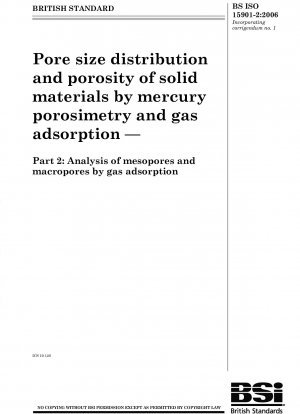BS ISO 15901-2:2006(2007)
Pore size distribution and porosity of solid materials by mercury porosimetry and gas adsorption - Analysis of mesopores and macropores by gas adsorption
- Standard No.
- BS ISO 15901-2:2006(2007)
- Published By
- British Standards Institution (BSI)
- Status
- 2022-02
- Replace By
- BS ISO 15901-2:2022
- Latest
- BS ISO 15901-2:2022
- Scope
- This part of ISO 15901 describes a method for the evaluation of porosity and pore size distribution by gas adsorption. It is a comparative, rather than an absolute test. The method is limited to the determination of the quantity of a gas adsorbed per unit mass of sample at a controlled, constant temperature. This part of ISO 15901 does not specify the use of a particular adsorptive gas, however nitrogen is the adsorptive gas most commonly used in such methods. Similarly, the temperature of liquid nitrogen is the analysis temperature most commonly used. Use is sometimes made of other adsorptive gases, including argon, carbon dioxide and krypton, and other analysis temperatures, including those of liquid argon and solid carbon dioxide. In the case of nitrogen adsorption at liquid nitrogen temperature, the basis of this method is to measure the quantity of nitrogen adsorbed at 77 K as a function of its relative pressure. Traditionally, nitrogen adsorption is most appropriate for pores in the approximate range of widths 0,4 nm to 50 nm. Improvements in temperature control and pressure measurement now allow larger pore widths to be evaluated. This part of ISO 15901 describes the calculation of mesopore size distribution between 2 nm and 50 nm, and of macropore distribution up to 100 nm. The method described in this part of ISO 15901 is suitable for a wide range of porous materials, even though the pore structure of certain materials is sometimes modified by pretreatment or cooling. Two groups of procedures are specified to determine the amount of gas adsorbed: -- those which depend on the measurement of the amount of gas removed from the gas phase (i.e. gas volumetric methods), and -- those which involve the measurement of the uptake of the gas by the adsorbent (i.e. direct determination of increase in mass by gravimetric methods). In practice, static or dynamic techniques can be used to determine the amount of gas adsorbed. To derive pore size distribution from the isotherm, it is necessary to apply one or more mathematical models, which entails simplifying certain basic assumptions.
BS ISO 15901-2:2006(2007) history
- 2022 BS ISO 15901-2:2022 Pore size distribution and porosity of solid materials by mercury porosimetry and gas adsorption - Analysis of nanopores by gas adsorption
- 0000 BS ISO 15901-2:2006(2007)
